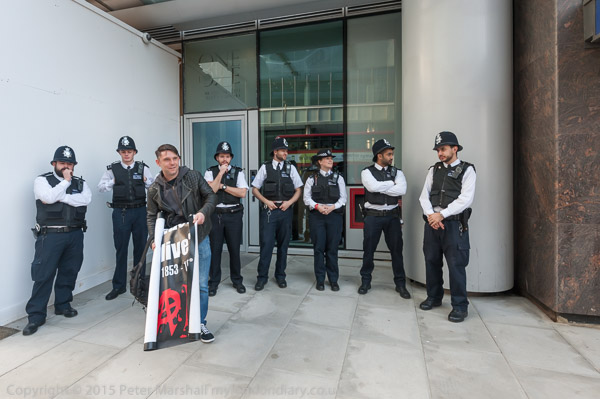
Police seemed almost pleased to see Class War as they turned up for the weekly protest outside the ‘rich door’ of One Commercial St. In general these events are a fairly easy and straightforward part of their job, just standing around in front of a doorway, and the protesters are generally little problem. The door wasn’t in use, and the entrance foyer seemed empty and in darkness; presumably the wealthy residents had been told to leave and enter by another route, perhaps through an interconnecting door with the hotel or another of the businesses with a ground floor entrance on one of the three roads around the block. Not however through the ‘poor door’ in the alley, although they can normally enter or exit through this if they choose. At least one resident uses it when walking her dog!
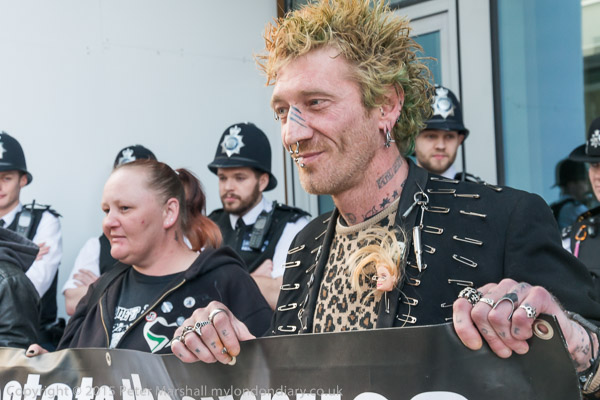
The protesters provide the police with a little entertainment – and sometimes a little fairly gentle ribbing, reminding them they are class traitors, protecting the interests of the ruling class who have, the protesters remind them, been attacking police pay and conditions.
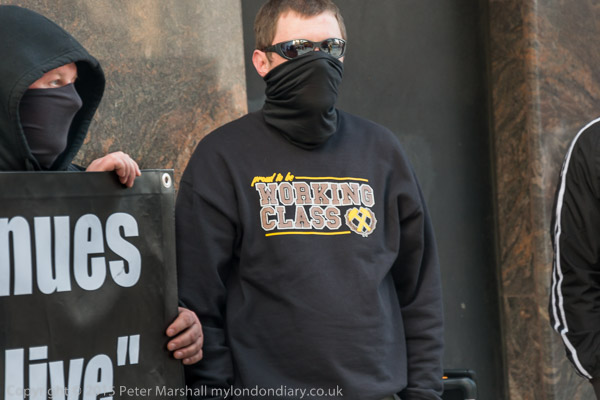
One of the protesters was wearing a sweatshirt with the message ‘proud to be Working Class‘ and the protesters appealed to the police to be proud of their class origins and come and join them in the protest, but it surprised none of us present they did not take up the offer.
The officers were perhaps disappointed when the protest ended early – as one of the organisers pointed out they would get less overtime. But Class War had received a request for support from the two groups, Squatters and Homeless Autonomy and Autonomous Nation of Anarchist Libertarians, occupying some offices in St James’s Square, empty for some years after having been used by the Institute of Directors, who were being illegally harassed by bailiffs, and I was invited to accompany a group of them who were making their way there.

The laws on squatting are quite clear. In non-residential properties trespass is not a criminal offence, and there are proper procedures that property owners should employ to regain their property, including going to court to get a possession order. Usually these give squatters 24 hours notice to leave, after which staying in the property is a criminal offence, and police can aid bailiffs in a properly managed eviction.
Other laws protect the rights of occupiers of property (whether squatters or not) giving them the right to leave and enter the property. There are also laws against assault, and governing the actions of security guards.
Clearly when we arrived, several of these laws were being broken. People were being prevented from entering the premises by men dressed in black. And by not wearing visibly their SIA licence these security guards were committing a criminal offence under the Private Security Industry Act 2001 which should result in their losing their licence; it’s an offence punishable by up to 6 months in prison – nd/or a fine of up to £5,000. When people attempted to enter, they were also clearly being assaulted by these men.
As in many other cases, the police generally seem to be choosing not to apply the law against these illegal activities by security guards, employed by companies that boast of being able to get around the delays of legal evictions. The same company that these men were working for have also been employed by Southwark Council to work in a similar illegal fashion on the Aylesbury estate.
The police (or their political masters) should not be allowed to chose which laws to enforce and which to ignore in this way. On this particular occasion, Class War were able to help the protesters to persuade the police to act, if only in a fairly desultory fashion. The officer who eventually turned up – I think following a complaint by someone from Class War did listen to the protesters and did make some attempt to sort things out, but was unable to get the security guards to comply with the law. There were no arrests, no people facing prosecution for their illegal actions, but eventually the security firm was persuaded to call off their action after getting a phone call from the police station. They left smiling and returned the following morning to illegally finish the job with the help of police.
When it comes down to it, we do have one law for the rich, which generally overrides the interests of the 99% and the niceties and fair dealing that Parliament has decided in its legislation.
It isn’t always easy to photograph at events like this. There are people who don’t trust the media and their lack of trust is unfortunately often well-deserved, with protesters often being treated very unfairly in print and on screen. Though it’s normally by editors and journalists who were not at the scene rather than by photographers. But I had been invited by some of those present, and knew a number of the others present, at least slightly, from other protests that I’ve taken pictures of, and had few problems. The protesters too had the law (if not the police) on their side, and it was others that were breaking it.
I’d set both cameras (Nikon D700 ande 800E) to ISO 3200 on the tube journey, as the light was beginning to fall outside, and when I started taking pictures, I was getting exposures around 1/250 at f8; by the time I left it was down to 1/30 f3.5, and it was getting too low to work sensibly as people were moving. I don’t really have any fast lenses for the Nikons, partly to cut down weight; nothing faster than f2.8, and the only f2.8 lens I had with me was the 16mm fisheye, which I didn’t use. The 16-35mm is an f4 lens and the 18-105mm is f/3.5-5.6, getting rather slow at the longer end. Towards the end of the time I was there I was feeling the lack of something faster. I had some problems with subject movement during the few scuffles too, with shutter speeds of around 1/125 causing some images to be blurred.
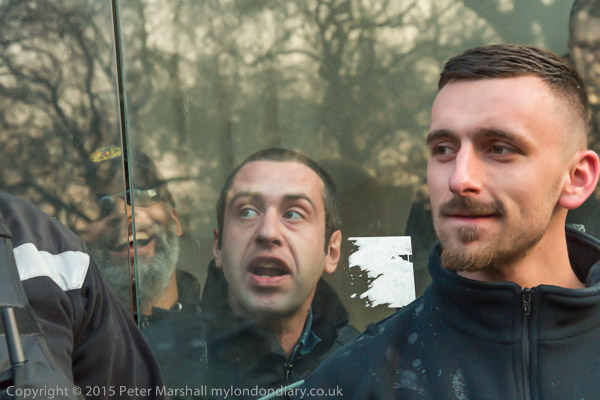
One problem – but also something that made many of the pictures possible, was that the doors which were being blocked were glass. It meant I could see through them, but also that at times reflections in them limited what I could do.
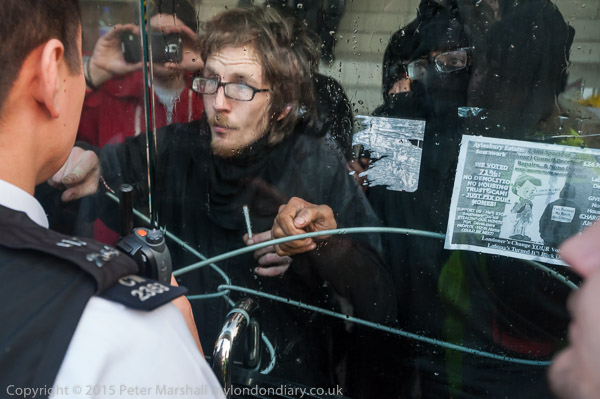
Photographing the people inside them through the glass was possible, but the glass was rather dirty – the building had been out of use for some years – and also got wet in places when some water was thrown from an upper balcony.
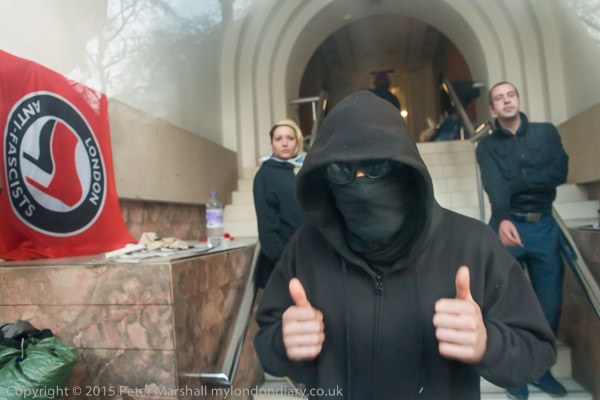
The light fell off very rapidly away from the doors inside the building, but I was able to take a few pictures with the lens held close to the glass to avoid reflections, using a hand to block some of them.
More pictures at Class War keeps up Poor Door protests and Illegal Security blocks St James occupation.
______________________________________________________
My London Diary : Buildings of London : River Lea/Lee Valley : London’s Industrial Heritage
All photographs on this and my other sites, unless otherwise stated, are taken by and copyright of Peter Marshall, and are available for reproduction or can be bought as prints.
To order prints or reproduce images
________________________________________________________